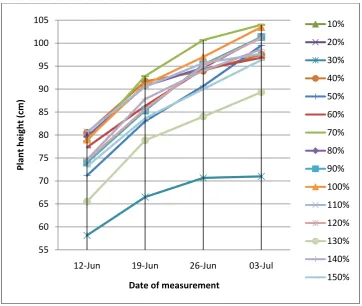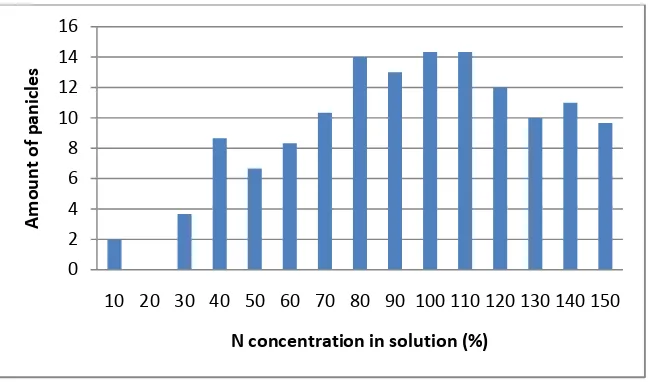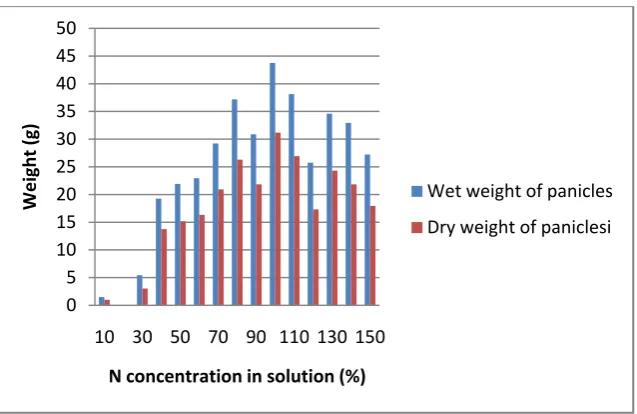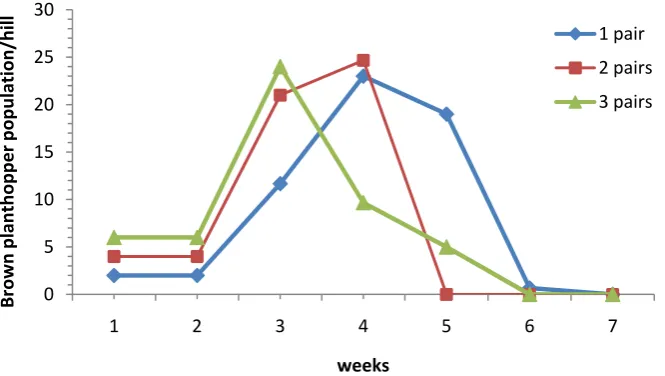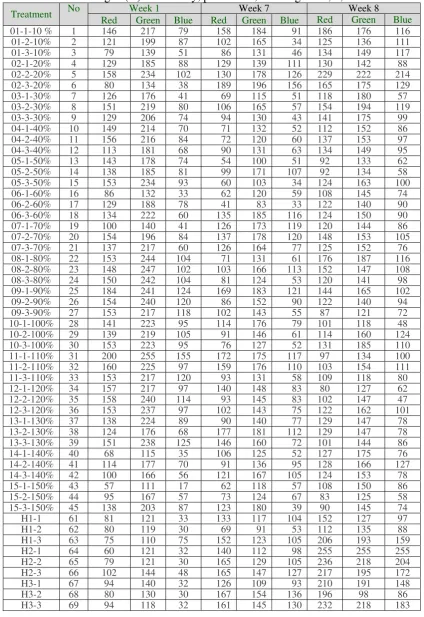ICGAI, Yogyakarta, INDONESIA, November 12-14, 2013 270
CONCENTRATION AND BROWN PLANTHOPPER INFESTATION
Partoyo1, Mofit Eko Purwanto1, Sari Virgawati1, Frans Richard Kodong2, Sri Sumarsih1 1
Agrotechnology Department, Faculty of Agriculture 2
Informatics Department, Faculty of Industrial Technology
UPN “Veteran” Yogyakarta
* Corresponding author: [email protected]
ABSTRACT
The information of recommended fertilizer dosage and pest control that is location-spesific is required by the farmer for the success of its agricultural cultivation. In this research, digital image analysis of the rice leaf sample was conducted to obtain a basis data for determining its nutrient sufficiency status and pest attack level. Hydroponic rice planting is performed in the green house with variations of nitrogen sufficiency and variations of brown planthopper population. Along the rice crop development, rice leaf photography is performed to capture the digital image of rice leaf from various treatments of nitrogen sufficiency variation, pest attack level variation, and plant period variation. The process of digital image processing is performed to obtain image parameter, which are Red (R), green (G), dan blue (B). The variation of nitrogen content from 10% - 150% of recommended dosage produces various rice leaf greenness, amount of tillers, amount of panicles, and plant biomass weight. The increase of nitrogen content from 10% - 150% causes color diversity from greenish yellow with the value of R: 86, G: 131, and B: 46, to dark green with the value of R: 119, G: 169, and B: 72. Rice crop that is attacked by brown planthopper changes from green with the value of R: 206, G: 193, and B: 159 into brownish yellow with the value of R: 196, G: 98, and B: 86 along with the increase of it population.
Keywords: rice crop, nitrogen, planthopper, digital image.
INTRODUCTION
price is a stimulation to improve the efficiency of agro-business system especially the efficiency of fertilization on rice field which is the biggest fertilizer consumer. Therefore, the determination of precise fertilizer dosage becomes urgent for achieving an efficient fertilization.
In 2010, Education for Sustainable Development (ESD) UPN “Veteran” Yogyakarta research team conduct a research about the application of Precision Agriculture (PA) concept and technology in several district in Magelang Regency (Virgawati et al., 2010). Precision Agriculture designs soil and crop management carefully according to diversity that is found in the land (Shibusawa, 2001). Plant and characteristic of soil in the land is not only varied on distance and depth, but also time. This diversity problem becomes the basic difference between Precision Agriculture dan Conventional Agriculture (Srinivasan, 2006).
Pest attack often becomes a problem in the rice productivity improvement effort. The main rice pest in Indonesia is green planthopper and brown planthopper. Green planthopper is a vector that spreads ‘tungro’ disease while brown planthopper spreads dwarf virus. This pest can form a huge population only in a short time and damage plants on every single growth phase. Planthopper attack can cause a loss whose amount is depended on the attack level, from low attack level until fail to pay back level (Anonim, 2010).
This research is designed to produce information especially recommended fertilizer dosage and pest control that is location-specific. For that reason, digital image analysis of the rice leaf sample was conducted to obtain a basis data for determining its nutrient sufficiency status and pest attack level. This research is aimed to assemble technology that combines artificial neural network (ANN) technique with digital image data communication technique to determine fertilizer need and pest control recommendation. This technology is designed so that the farmer can find out recommended fertilizer dosage and pest control recommendation needed for the agricultural land only by sending data in the form of rice leaf image through short messages (MMS) to the system.
MATERIALS AND METHODS
The details of each phase are as follow:
A. Hydroponic rice planting in green house with nitrogen nutrient sufficiency variation and pest attack level variation.
1. This phase begins with preparing plant media in the form of river sand. Before used, the sand is cleansed with tap water until the water is clear. The aim is to remove materials except sand that are possible to carry nutrition.
2. Planting is performed in 69 plastic pots, consists of 23 treatments with 3 repetitions. The variety chosen is Ciherang with consideration as the most popular variety that is planted in the research area and shows a clear visual indication of planthopper attack.
ICGAI, Yogyakarta, INDONESIA, November 12-14, 2013 272 110%,120%, 130%, 140%, 150%.Meanwhile, for the pest attack treatments, rice is planted with optimum hydroponic media composition (100%) and infested with brown planthopper with population 1, 2, and 3 pair of adult planthopper (age of 4 days) with male and female comparison of 1:1 to arouse pest attack level variations.
4. The plant is kept until harvest age.
B. Observation of plant growth and planthopper population
1. Growth of the rice plant was observed for plant height, wet and dry weight of plant biomass, amount of tiller, and amount of panicle per pot.
2. Population of planthopper was observed every week from week 1 until week 7 to monitor the population change.
C. Photography of hydroponic rice leaf in green house.
1. This photography is performed to record digital image of rice leaf from various treatments of nutrient sufficiency variation, pest attack level variation, and plant age variation. This photography is performed by using digital camera Canon EOS 500D.
2. This photography is performed on selected leaf sample that has been completely developed (fully expanded leaf), starting from plant age of three weeks after transplanting (WAT) in 10 days of interval. This photography is performed until it comes into bud.
D. Parameter analysis of the digital image of rice leaf.
The process of digital image processing is performed to obtain image parameters, which are: Red (R), Green (G), dan Blue (B).
RESULT AND ANALYSIS
The plant height is mostly ranged between 95 and 105 cm. There are two treatments that produce plant height below 90 cm, i.e. 30% and 130% N concentration. The four topmost plant heights are treatment of 70%, 80%, 90%, and 100% (Figure 1). This result indicates a better nitrogen sufficiency in those four levels of nitrogen concentration.
Figure 1. The average height of rice crop up to maximum vegetative
The pattern of amount of tiller per hill is similar to the average amount of panicles per hill (Figure 3). The weight of panicles per hill is connected with the amount of panicles per hill so that the weight diversity of panicles is similar with the amount of panicles per hill pattern (Figure 4). It can be seen that the most weight panicle was produced by 100% N concentration treatment.
The weight of plant tissue which includes straw and root shows that on treatment with nitrogen content higher than 100% until 150% produced plant tissue weight that is similar to treatment with nitrogen 100% (Figure 5). The rice straw on treatment with high nitrogen content (above 100% of dosage) still shows a high vegetative growth during panicles maturation. One of the indications is the leaf which tends to be constant in green although the panicles have turned into yellow until harvest age. Nevertheless, the produced tissue contained less dry weight as compared to 100% N concentration treatment (Figure 5).
55 60 65 70 75 80 85 90 95 100 105
12‐Jun 19‐Jun 26‐Jun 03‐Jul
Plant
height
(cm)
Date of measurement
10%
20%
30%
40%
50%
60%
70%
80%
90%
100%
110%
120%
130%
140%
ICGAI, Yogyakarta, INDONESIA, November 12-14, 2013 274 Figure 2. The average amount of tillers per hill at the harvest time
Figure 3. The average amount of panicles at the harvest time 0
2 4 6 8 10 12 14 16
10 20 30 40 50 60 70 80 90
100 110 120 130 140 150
maunt
of
tillers
N concentration in solution (%)
12 June
19 June
26 June
3 July
0 2 4 6 8 10 12 14 16
10 20 30 40 50 60 70 80 90 100 110 120 130 140 150
Amount
of
panicles
Figure 4. The average wet and dry weight of panicles
Figure 5. The average wet and dry weight of plant tissue
The experiment pot that is infested with brown planthopper is made into three limits of initial planthopper population with three repetitions and it uses hydroponic nutrition composition with 100% of nitrogen content. The experiment pot of brown planthopper attack is given a cover made from mica sheet. The infestation of brown planthopper is performed when the rice crop attains the age of 1 week. The population of brown planthopper is observed every 7 days so that the fluctuation of planthopper population can be obtained. The initial population of brown planthopper influences the population development. The rice crop that is infested with adult brown planthopper (imago at the age of 4 days) with higher initial population will develop its population faster. The population of brown planthopper with three pair initial population is developed faster than two pair and one pair initial population. This rapid population increase is followed by rapid decrease as well. Rice crop that is relatively young is more sensitive toward brown planthopper attack, so that the high population will rapidly decrease its ability to provide nutrition for the next offspring. The low initial population will increase
0 5 10 15 20 25 30 35 40 45 50
10 30 50 70 90 110 130 150
Weight
(g)
N concentration in solution (%)
Wet weight of panicles
Dry weight of paniclesi
0 50 100 150 200 250
10 30 50 70 90 110 130 150
Weight
(g)
N concentration in solution (%)
Wet weight of plant tissue
ICGAI, Yogyakarta, INDONESIA, November 12-14, 2013 276 population slowly and the crop damage as well, so that the population of brown planthopper will decrease slowly as the plant is increasingly damaged (Figure 6).
Figure 6. The population dynamic of brown planthopper on rice crop Ciherang variety, with initial population of 1, 2, and 3 pairs
The digital image parameter that has been successfully extracted from the data of leaf image for all treatments is Red, Green, dan Blue (RGB). The output of digital image processing is listed on Table 1.
0 5 10 15 20 25 30
1 2 3 4 5 6 7
Brown
planthopper
population/hil
l
weeks
1 pair
2 pairs
Table 1. The parameter of digital image of rice leaf from a number of variations of nitrogen (N) sufficiency, pest attack, at the age of 1, 7, and 8 weeks
Treatment No Week 1 Week 7 Week 8
Red Green Blue Red Green Blue Red Green Blue
Deptan RI, 2007. Peraturan Menteri Pertanian Nomor 40/Permentan/OT.140/04/2007 tentang Rekomendasi Pemupukan N, P, dan K Pada Padi Sawah Spesifik Lokasi. http://www.litbang.deptan.go.id/regulasi/one/11/file/Revisi-Permentan-no-40.pdf. diakses 2 Mei 2012.
Dibike,Y.B., and D.P.Solomatine. 1999. River Flow Forecasting Using Artificial Neural Networks. http://www.ihe.nl/hi/sol/papers/EGS99-annriverflow.pdf
Fu, L.M. 1994. Neural Network in Computer Intelligence. McGraw-Hill,Inc. New York. 459p
Hermantoro, 2011. Prediksi Kadar Bahan Organik Tanah dengan Pengolahan Citra dan Jaringan Syaraf Tiruan Menggunakan Telepon Genggam. Prosiding Seminar Nasional Informatika Pertanian 2011 “Akselerasi Pengembangan Informatika Pertanian untuk Pemberdayaan dan Perlindungan Petani”.
Munir & Rinaldi. 2004. Pengolahan Citra Digital. Informatika Bandung. Bandung. Paola, J. D. & Schowengerdt, R. A., 1995. A detailed comparison of neural network and
maximum likelihood classifiers for urban land use classification, IEEE Trans. Geosci. Remote Sensing 33 (4), 981-996.
Pham, D.T. 1994. Neural Network for Chemical Engineers. Elsevier Press. Amsterdam. Pujiharti, Y., J. Barus, dan B. Wijayanto. 2008. Teknologi Budidaya Padi. Seri buku
inovasi: TP/01/2008. Balai Besar Pengkajian dan Pengembangan Teknologi Pertanian. Badan Penelitian dan PEngembangan Pertanian RI. 30hal.
Srinivasan, A. (2006). Precision Agriculture: An Overview. In A. Srinivasan (Ed.), Handbook of Precision Agriculture: Principles and Applications (pp. 3-18). New York: The Haworth Press Inc.
Suyamto, 2010. Strategi dan Implementasi Pemupukan Rasional Spesifik Lokasi. Pengembangan Inovasi Pertanian, 3(4), 306-318
Toth, E., & Brath, H. 2002. Flood Forcasting Using Artificial Neural Networks in Black-Box and Conceptual Rainfall-Runoff Modelling. Http://www.iemss.org/ iemss2002/proceedings /pdf/-volume%20ue/370_toth.pdf
Tri, Y., 2012. Pemberdayaan Petani melalui Denfarm Padi. Sinar Tani Edisi 22-28 Februari, No. 3445, Tahun XLII.
Virgawati, S., S. Sumarsih, F.R. Kodong, D. Nuryadin, E. Murdiyanto, H. Lukito, & W. Choiriyati, 2010. Pusat Kegiatan Belajar Masyarakat (PKBM) Sebagai Media Penerapan Teknologi Precision Farming dengan Decision Support System untuk Optimalisasi Pengelolaan Tanaman Pangan Ramah Lingkungan. Laporan Akhir Hibah Penelitian ESD DP2M Dikti.
Yoshida S, Forno DA, Cock JH, Gomez KA, 1976. Laboratory Manual for Physiological Study of Rice. IRRI. Los Banos. The Phillipines. 83p.
Steering
& Scientific committee
1. Prof. Sakae Shibusawa – Tokyo University of Agriculture and Technology, Japan
2. Prof. Dr. Nilda Burgos – University of Arkansas, USA 3. Prof. Dr. Lin Qing – Fujian Normal University, China
4. Prof. Paul Holford – University of Western Sydney, Australia 5. Prof. Sri Rahardjo – Universitas Gadjah Mada, Indonesia
6. Prof. Suharto – Universitas Pembangunan Nasional “Veteran” Yogyakarta, Indonesia
7. Prof. Jesusa D. Ortuoste – Sultan Kudarat State University, Philippines 8. Prof. Sulaiman Hanapi – Universitas Malaysia Sarawak, Malaysia 9. Prof. Endang Gumbira Sa’id – Bogor Agricultural University, Indonesia 10. Dr. Wimalaratana - University of Colombo, Sri Lanka
11. Dr. Coen van Ruiten – HAS den Bosch, Netherlands
12. Dr. Rosa S. Rolle – Agricultural and Food Engineering Technologies Service, FAO Agricultural Support Systems Division, Thailand)
13. Dr. Siti Syamsiar – Universitas Pembangunan Nasional “Veteran” Yogyakarta, Indonesia
14. Dr. Setyo Wardoyo – Universitas Pembangunan Nasional “Veteran” Yogyakarta, Indonesia
15. Ratna Roostika, PhD – Universitas Pembangunan Nasional “Veteran” Yogyakarta, Indonesia
16. Partoyo, PhD – Universitas Pembangunan Nasional “Veteran” Yogyakarta, Indonesia
Organizing Committee Members
Chair person : Assoc. Prof. Dr. Sri Wuryani Vice chair person : Dr. Rr. Rukmowati Brotodjojo
Secretary : Dr. Mofit Eko Poerwanto, Sari Virgawati, Tuti Setyaningrum
Treasure : Dyah Arbiwati, Dwi Aulia Puspitaningrum
Proceeding and Paper : Dr.Oktavia Sarhesti Padmini, Dr. Yanisworo WR, Indah Widowati, R. Agus Widodo
Program Section : Ari Wijayani, Heni Handri Utami, Vini Arumsari, Dr. Budyastuti
Presentation : Ellen Rosyelina Sasmita, Dr. Budiarto, Didi Saidi Food and Beverage : Wulandari D.E.R, Heti Herastuti,
Sponsorship : Dr. Mustajab Hery Kusnadi, Vandrias Dewantoro Accommodation and
Publication
: Darban Haryanto, Lanjar Sudarto, Tutut Wirawati, Agus Santosa, Endah Budi Irawati, Endah Wahyurini,
Over the past decades, rapid growth of global economic has lifted millions of people out of poverty. In line with rising population, rapid urbanization, and industrialization, it has also led to increase consumption of resources and generate of waste almost beyond the limits of the ecological carrying capacity.
The coming decades will likely witness of the increasing pressures on industries to shift to more resource-efficient and low-carbon production processes as part of global efforts to sustain growth, conserve resources and slow down the pace of climate change. Countries and regions that successfully manage this transition will get a better position to exploit the opportunities created by the shift towards a low-carbon world economy. It is green industry's initiation, a pattern of industrial development that is sustainable in economic, environment and social.
Universitas Pembangunan Nasional "Veteran" Yogyakarta in conjunction with its global partners is proud to announce the International Conference on Green Agro-Industry, to be held on November 11-14, 2013, at Yogyakarta, Indonesia. The basic aim of the conference is to contribute to the development of highly productive methods and technologies for the various segments of the agro-industries. This conference is designed to provide a forum for the presentation, discussion and debate on state-of-the-art and emerging technologies in the field of agro based industry and any issues related to sustain the environment.
Finally, we would like to express our gratitude to the Rector UPN “Veteran”, Yogyakarta for the financial support, the Dean of the Faculty of Agriculture for hosting, and the Scientific and Steering Committee. We wish to thank the keynote speaker Director of PT Astra Agro Lestari Tbk and Plenary Speakers: Prof. Sakae Shibusawa (Tokyo University of Agriculture and Technology, Japan), Prof. Raj. Khosla, Ph.D. (Colorado State University, USA), Prof. Dr. Nilda Burgos (University of Arkansas, USA) Ir. Toine Hattink (Director of Department of Horticulture, HAS den Bosch, Netherlands) Prof. Dr. Endang Gumbira Sa’id (Bogor Agricultural University, Indonesia) . Nur Iswanto, PhD. (IKAGI, International Society of Sugar Cane Technologists Councillor), Prof. Wijitapure Wimalaratana. (Department of Economics, University of Colombo), Prof. Hassan M. El Shaer (Desert Research Center, Cairo, Egypt), Dr. Mofit Eko Poerwanto (UPN “Veteran” Yogyakarta, Indonesia) as well as participants for their contribution in making the International Conference on Green Agro-Industry.
We wish to thank PT Astra Agro lestari as the major sponsor and all other sponsors for their contribution in making this Conference possible. As a Chairperson, I highly appreciate the great efforts of the members of the organizing committee whose hard work made this seminar a great success.
Table of Contents
Committees Preface
Keynote Speaker
Managing Green Agro-Industry: Economic, Environmental and Social
Consideration. PT Astra Agro Lestari Tbk (Joko Supriyono)
K - 1
Plenary Speakers:
1 Eco-friendly agrochemicals practices to support green agro-industry.
Nilda Burgos. University of Arkansas, USA.
P-1
2 Sustainable Horticulture Supply Chains. Toine Hattink. Director of Department of Horticulture, HAS den Bosch, Netherlands.
P-10
3 Zero waste technology in green agro-industry: Special Case for Palm Oil Industrial Cluster. Endang Gumbira Sa’id (Bogor Agricultural
University, Indonesia)
P-17
4 Integrated Sugar Industry: Maximizing Energy Utilization of the Cane.
Nur Iswanto. IKAGI, International Society of Sugar Cane Technologists
Councillor.
P-30
5 Economic Perspective Of Sustainable Agro Industry. Wijitapure
Wimalaratana. Department of Economics, University of Colombo
P-39
6 Implementation of precision farming in green agro-industry concept.
Sakae Shibusawa. Department of Environmental and Agricultural
Engineering, Tokyo University of Agriculture and Technology, Fuchu, Japan
P - 45
7 New approaches in Management and Utilization of Agriculture Wastes in the WANA Region. (Hassan M. El Shaer) (Desert Research Center, Cairo, Egypt)
P-53
8 Implementation of green agriculture technology for reducing CVPD.
Mofit Eko Poerwanto. UPN “Veteran” Yogyakarta, Indonesia)
1 Micro, Small and Medium-Sized Enterprises of Banana’s Variety
Products to Support the Green Agro-Iindustry. (Heni Handri Utami, Siti Hamidah)
1
2 Impact of Plant Conservation on Additional Income Generation in Rural Gardens: A Case Study of Talawi Mudik Village of West Sumatera.
(Sumilah, Nirmala F. Devy and Hayani)
8
3 The Role of Women in Developing Entrepreneur / Merchandise Case in Maju Makmur Small Group Activity (Sga) Kejajar District, Wonosobo Regency, Central of Java. (Teguh Kismantoroadji and Indah
Widowati)
16
4 Analysis Effect Of Environmental Food Production Toward Consumer’s Intermediate Behaviour Product Slice Noodle. (Novita Erma K.)
21
Agronomy
1 Application of Agricultural Waste to Reduce Inorganic Fertilizer and Improve Sugarcane Plant Resistance to Stem Borer Attack. (R.R.
Rukmowati Brotodjojo, Oktavia S Padmini, Saefudin Saeroji)
31
2 Climatic Factor in Epidemic of Vascular Streak Dieback of Cocoa
(Herry Wirianata, Suprih Wijayani, Elisabeth Nanik K)
40
3 The Effectiveness of Several Dosages of Sour-Sop (Annonna Muricata L.) Leaves and Seeds Powder for Controling Callosobruchus Sp. and
Maintaining the Quality of Mungbean Storaged Seeds. (Ami Suryawati ,
Chimayatus Solichah)
45
4 Filed application of Oberon®and Envidor® on oligonychus sacchari (prostigmata: tetranychidae) and its predator stethorus punctillum (Coloptera: Coccinellidae).(Amin Nikpay, Masoud Arbabi, Peyman
Sharafizadeh, Mahmood Poormahmood)
54
5 Implementation of Mineral Oil for Controlling Aphid and White Rust
Disease of Chrysanthemum. (Mofit Eko Poerwanto & Ari Wijayani)
60
6 The Role of Weeds in the Spread of Vector of Peanut Stripe Virus
(PSTV). (Mofit Eko Poerwanto, Siwi Hardiastuti EK)
66
7 In Vitro and In Vivo DigestibilityEvaluation of Bacillus Phytases in Plant Ingredients and Diets by Tilapia, Oreochromis Mossambicus (Rande B.
Dechavez , Augusto E. Serrano Jr.)
9 Evaluation of the Effect of Azospirillum-like Bacteria on the Growth and Yield of Green Onion (Allium cepa L.). (Carlos E. Lacamento)
96
10 Characterization and Evaluation of Microflora Bacteria on Various
Plantation Soils Against Phytophthora Capsici of Black Pepper (Piper Nigrum L.), (Awang Ahmad Sallehin Awang Husaini, Linda Nirwana Caroline, Samuel Lihan, Hairul Azman Roslan, Mohd Hasnain Md Hussain)
106
11 Heterologous Expression of Xylanase Gene from Klebsiella Pneumoniae in E. Coli Bl21 (De3) for Potential Use in Green Technology. (Suhaila Zainol, Nikson Fatt Ming Chong, Awang Ahmad Sallehin Awang
Husaini)
113
12 Genetic Diversity of Fusarium Wilt Resistant Potato Planlet Produced by
Gamma Ray Irradiation. (Rahayu Sulistianingsih, Rina Sri Lestari and
Ari Wijayani)
118
13 Nutrient Analysis of Palm Empty Fruit Bunch, Palm Fruit Fibers and
Sawdust as Media for White Oyster Mushroom Cultivation.
(Sulistiyanto. Y , Balfast. Usup. A)
125
14 Growth and Yield of Sweet Potato Varieties Using Organic and Inorganic
Fertilizers and Vermitea. (Ana Maria F. Maglalang , Tessie E Navarro)
135
15 Use of Poultry Manure as Carrier for Biofertilizers: Effects on Maize (Zea
Mays) Growth. (Tunde Ezekiel Lawal, Olubukola Oluranti Babalola)
147
16 The Effect of Various Fertilizers on the Growth of Oil Palm Seedlings in
The Main Nursery. (Pauliz Budi Hastuti , Ni Made Titiaryanti)
154
17 Gibberellic Acid Synthesis in the Developing Seeds of Cocoa ( Yohana
Theresia Maria Astuti, Kumala Dewi, Santosa, A. Adi Prawoto)
161
18 Alternative Propagation Technology for Rubber (Hevea Brasiliensis).
(Onofre S. Corpuz)
169
19 Testing and Evaluation of Upland Rice Varieties in Sultan Kudarat
Province ( R. Ortuoste , J. Ortuoste)
182
20 Improvement of Wheat (Triticum Aestivum L.) Crop Tolerant in Lowland
through Mutation Induction. (Budyastuti Pringgohandoko)
193
21 Utilization of Waste Palm Oil as a Source Soil Organic Matter for Support
Green Agroindustry. (S. Setyo Wardoyo)
23 Land Management Salak Pondoh (Salacca Edulis Reinw) Especially
Based on Altitude at Turi Sleman. (Subroto Padmosudarso)
220
24 Development of Purwaceng (Pimpinella pruatjan Molkenb) to Support
Herbs Industry and Soil Conservation in Dieng Plateau, Central Java.
(Partoyo, Eko Amiadji Julianto, M. Husain Kasim, Teguh
Kismantoroadji, and Indah Widowati)
226
25 Isolation and Characterization of Humic Acid of Various Waste Matterial
on Saline Soil and Their Effects to Paddy. (Wanti Mindari, W.
Guntoro, Zaenal Kusuma, Syekhfani)
234
Clean Technology
1 LCA Methods on The Treatment of Biomass Residues In a Palm-Oil
System. (Edi Iswanto Wiloso, Reinout Heijungs)
243
2 Reducing Ammonia Gas Concentration from Composting of Leftover
Food by Natural Zeolite from Japan (Ida Ayu Gede Bintang Madrini,
Sakae Shibusawa, Yoichiro Kojima, Shun Hosaka)
254
3 A Study of Soil Adsorption Toward Chromium in Liquid Waste from
Tanning Industry (Agung Sahida, Sari Virgawati, AZ. Purwono)
260
Agriculture Enginering
1 Growth and Leaves Digital Image Analysis of Rice Cultivated in Various
Levels of Nitrogen Concentration and Brown Planthopper Infestation.
(Partoyo, Mofit Eko Purwanto, Sari Virgawati, Frans Richard
Kodong, Sri Sumarsih)
270
2 Productivity, Soil Fertility, and Economic Benefit in Changes from
Conventional to Organic Rice Farming System at Sragen District.
(Oktavia Sarhesti Padmini),
280
3 Utilization of visible-Near Infrared Real-Time Soil Sensor as a Practical
Tool for Precision Carbon Farming Practice. (B. S. N. Aliah, S.
Shibusawa, M. Kodaira)
288
4 Designing of Ergonomic Soybean Grinder to Increase Industry
Productivity (Case Study on Home Industry of “Tempe” In Bantul, Yogyakarta). (Dyah Rachmawati Lucitasari and Deny)
Other Topic
1 Study of Growth Hormone Gene Variety Based on Bioinformatics.
(Mariana Rengkuan)
308
2 SWOT Analisys for Integrated Eco-Tourism Development in
Strengthening National Resilience (Case Study in Gajah Wong River, Yogyakarta, Indonesia). (Istiana Rahatmawati)
318
3 People Empowerment throught Green Water Resources (Study in Gajah
Wong River) (Purbudi Wahyuni)
327
Poster
1. Prospect of Clove Leaf Based Essential Oil Industry in Indonesia: A Case Study of District Samigaluh Kulonprogo Regency (Juarini, Ni Made
Suyastiri YP)
335
2 The Analysis of Technological Contribution and Competitiveness of Cokrotela Cake Company Yogyakarta to Support Green Agroindustry. (Sri Wuryani, Budiarto, Ani M. Nurhayati)
344
3 Effect of Varieties and Blanching for Making Cocoyam (Xanthosoma Sp) Flour and Food Product. (S.S. Antarlina , P.E.R. Prahardini, S.S. Antarlina , P.E.R. Prahardini)
351
4 Diversified Food Products of Pumpkin (Cucurbitamoschata). (Aniswatul Khamidah , SS. Antarlina)
359
5 Fresh Calyses as Health Drink from Roselle Cultivation in Polybags Utilizing Open Spaces at Home. (Sugeng Priyanto and Wahyu Widodo)
371
6 Growth Performance and Potential Oil Content of Several Basil (Ocimum Basilicum Linn) Variety as Fruit Fly Controller (S. Yuniastuti, L
Rosmahani, E Korlina, W. Handayati)
375
7 Survival of Sugarcane White Grub in Treated Soil by Enthomopathogenic Fungi (Harjaka T, B.H. Sunarminto, E. Martono)
381
8 Application of Nano Particles in Pest Management Programs - A Review.
(Masumeh Ziaee, Fatemeh Hamzavi)
10 Screening of Sweet Potato Genotypes for Water Stress Resistance. (Agnes
C. Perey, Belinda A. Tad-awan)
403
11 Yield Potency of Sweet Potato Varieties under Drought Condition in Sandy Land. (Tutut Wirawati, Endah Budi Irawati, Ami Suryawati)
418
12 The Identification of Useful Vegetations on Different Ages of Oil Palm (Elaeis quineensis Jack). (Ety Rosa Setyawati)
424
13 Variation on Colchicine´S Concentrations and Germination Phases to Produce Polyploid Tomato Plant. (Rati Riyati, Nurngaini, Basuki)
433
14 Utilization of Critical Land for Tuber Crops Cultivation as Raw Materials of Agro-Industry (Bargumono, Tuti Setyaningrum)
440
15 Potential of Thermotolerance Isolates Bacteria from the Land that Affected by Merapi Eruption as a Plant Growth Promoting Rhizobacteria (PGPR). (Yanisworo W Ratih, Lelanti P Wiratri)
443
16 The Application of PGPR (Plant Growth Promoting rhizobacteria) on Chili Plant as an Interposed Plant between Salak Plant in Sub-District
Srumbung (Ellen R. Sasmita, Sri Sumarsih, Oktavia S. Padmini
and Endah B. Irawati)
451
17 A Study of Impact of Brick Industries on Soil Fertility in Potorono Banguntapan Bantul Yogyakarta (R. Agus Widodo, Susila
Herlambang)
462
18. The Potential of Groundwater on Unconfined Aquifer in Jogonalan Area Klaten Central Java. (Lanjar Sudarto)
469
19. Determination of Depth Groundwater Levels Based on Geophysical with Geoelectric Method Around the Prambanan Temple Region Yogyakarta Province. (Agus Santoso, Sismanto, Ari Setiawan, Subagyo)
